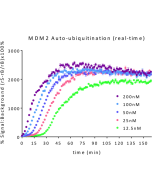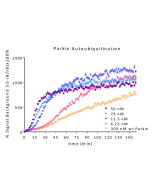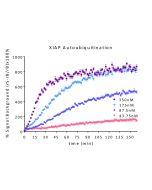Cookie Policy: This site uses cookies to improve your experience. You can find out more about our use of cookies in our Privacy Policy. By continuing to browse this site you agree to our use of cookies.
SouthBayBio
Nedd4 E3 Ligase TR-FRET Kit

| Product Details | |
|---|---|
| Synonyms | E3 Ubiquitin-protein Ligase NEDD4; Cell Proliferation-inducing Gene 53 Protein |
| Product Type | Kit |
| Properties | |
| Application Set | Compound Screening |
| Specificity |
Readout: Endpoint/Kinetic |
| Crossreactivity | Human |
| Quantity |
Sufficient Reagents for: |
| Kit Contains |
100x UBA1 (100μl) |
| Other Product Data |
The kit uses ubiquitin labeled with either Europium-Cryptate or Cy5 as FRET pair donor and acceptor fluorophores respectively, completely eliminating the need for antibody based detection setups. Enzymatic incorporation of the labeled ubiquitins into chains conjugated onto Parkin leads to an increase in fluorescence emission at 665nm (Em-Acceptor) and decrease at emission wavelength 620nm (Em-Donor). Click here for a Typical Lot-specific Product Datasheet from the Original Manufacturer |
| Declaration | Manufactured by South Bay Bio. |
| Shipping and Handling | |
| Shipping | DRY ICE |
| Short Term Storage | -20°C |
| Long Term Storage | -80°C |
| Handling Advice |
Aliquot to avoid freeze/thaw cycles. Avoid freeze/thaw cycles. |
| Documents | |
| Product Specification Sheet | |
| Datasheet |
 Download PDF Download PDF |
South Bay Bio’s NEDD4 E3 Ligase TR-FRET Kit provides a fast and sensitive method monitoring ubiquitin conjugation onto NEDD4 in solution, resulting from an enzymatic ubiquitin cascade without the need of running and staining an SDS gel. The kit enables continuous TR-FRET detection of ubiquitin chain formation onto NEDD4 in a real-time detection setup, or in an end-point configuration if desired. TR-FRET uses the extended fluorescence emission decay lifetimes typical of rare-earth lanthanides to impart a short time-delay between FRET donor excitation and emission. This delay provides a means to separate “true” signal from short-lived background fluorescence, and reduce interference from compound fluorescence and other assay artifacts.










